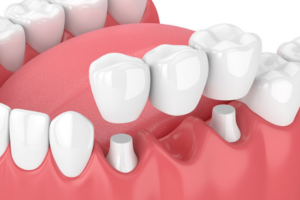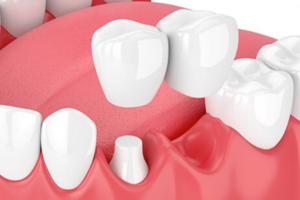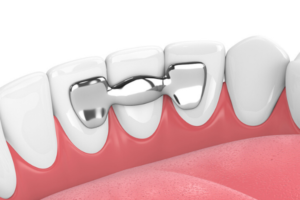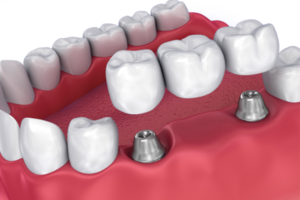A bridge is where a gap between teeth are filled in with replacement teeth. It fixes a replacement or false tooth (or teeth) to the natural teeth on either side of the gap, to cover the space between one or more teeth. It is a fixed prosthetic devices that are cemented onto existing teeth or implants by a dentist.
Benefits of a bridge:
- It fills in a gap and prevent a bad bite, caused by remaining teeth moving, next to the gap as well as overeruption of the opposing teeth
- A bridge lets you almost forget that you have missing teeth
- It can improve the way you look, bite, chew, and speak.
- The bridge can be matched to the colour of your own teeth.
- A bridge can last many years, as long as you keep it clean and if there is no accidental damage.
How are Bridges Made?
A bridge is made, by reducing the size and shape of the tooth to hold the bridge with false teeth in between. After reducing the tooth/teeth, your dentist will take an impression to provide an exact mold for the bridge and determine the correct shade for the bridge to match the colour of your existing teeth. This will be send to a dental laboratory who will make your bridge, in the material your dentist specifies.
A temporary bridge will be fitted to cover the prepared tooth/teeth, while the permanent crown or bridge is being made. When the permanent crown or bridge is ready, the temporary bridge is removed, the new bridge is cemented over your prepared tooth or teeth.
How Long does Bridges Last?
While bridges can last a lifetime, they do occasionally come loose or fall out. The most important step is maintaining good oral health you can take to ensure the longevity of your crown or bridge is to practice good oral hygiene.
“A bridge can lose its support if the teeth or bone holding it in place are damaged by dental disease. Keep your gums and teeth healthy by Brushing with fluoride toothpaste twice a day and flossing daily. Also see your dentist and hygienist regularly for dental health checks and professional cleanings. ”
There are 4 types of bridges:

Traditional Dental Bridges:
A traditional bridge is where we replace one or more teeth with false teeth (pontics) attached to your own teeth (abutments), with dental cement. These are traditionally the most popular kind of bridge. However, your natural teeth (adjacent to the gap) needs to be prepared by removing some of the enamel to create space for the bridge-crown to fit onto.

Cantilever Bridges
The second option is a Cantilever bridge, another option for replacing missing teeth. They are very similar to traditional bridges, but the pontic is supported by an abutment tooth on only one side only, rather than on both sides. However, it does depends on where the gap is and how healthy and strong the supporting tooth is. Because of the design, it can cause a lever effect.

Maryland Bridges
Maryland bridges are conservative alternatives to traditional bridges. These bridges are great in preserving tooth structure as it requires minimal preparation, but it relies mainly on cementation. The anchor tooth/teeth, adjacent to the gap, have metal or tooth colour coverage on the inside of the teeth, with the false teeth attached in the gap.
These types of bridges can debond, come out, more easily therefore one have to be more careful in what one eat and bite with them. However, one can always change to a different option as they are usually minimalistic in preparation.

Implant-Supported Bridges
Lastly, Implant supported bridges are another option for replacing missing teeth. This is where one or more missing teeth can be fixed by 1 or 2 implants , known as an Implant supported bridge.
These bridges are secured by implants, and they feel very secure and comfortable, just like the natural teeth they replace. Also see our Implant section.
